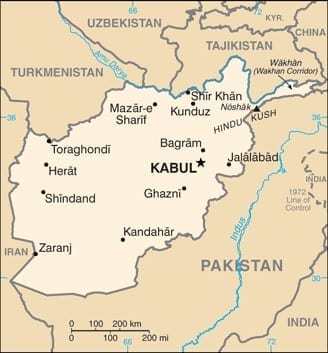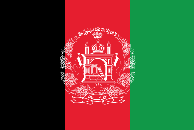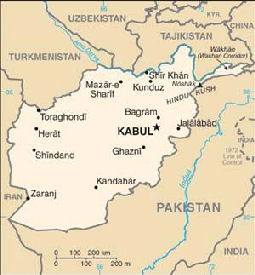Official Name: Islamic Republic of Afghanistan
National Symbol: Lion
Internet Domain: .af
International Dialing Code: +93
| Location and Size | Credit and Collections |
| Government | Risk Assessment |
| Legal System | Business Climate |
| Interesting Facts | Business Protocol |
| Economy | Other Sources of Info |
| Comparative Indicators |
Location and Size
Afghanistan is located in Southern Asia. The country is landlocked and bordered by Pakistan, Iran, Turkmenistan, Uzbekistan, Tajikistan and a small bit of China. The country’s land area is 652,230 sq. km., slightly smaller than Texas.
Government
Afghanistan’s current government is an Islamic republic with 34 provinces. The branches are as follows:
- Executive: Chief of state and head of government President Hamid KARZAI; First Vice President Mohammad FAHIM Khan; Second Vice President Abdul Karim KALILI; cabinet of 25 ministers appointed by the president and approved by the National Assembly
- Legislative: Bicameral National Assembly consisting of the House of Elders (102 seats) and the House of People (no more than 250 seats)
- Judicial: Supreme Court consists of nine judges appointed by the president for up to two non-renewable four-year terms; subordinate courts including Court of Cassation, which reviews decisions by the lower courts; Sharia Court (Islamic law).
Legal System
Afghanistan has a mixed legal system of civil, customary, and Islamic law.
The country has not submitted an International Court of Justice (ICJ) jurisdiction declaration. (What does this mean?) It does accept International Criminal Court jurisdiction.
Interesting Facts About Afghanistan
- Poetry is an important part of Afghan culture.
- Afghanistan’s centuries-old national sport is called Buzkashi (goat grabbing). Two teams riding horses try to catch a goat.
- Opium is the fastest and largest growing crop in Afghanistan.
- Life expectancy for men and women is approximately 44 years.
- Kite flying is one of Afghanistan’s national outdoor sports.
Economy
Afghanistan’s economy, which is recovering from decades of conflict, has improved significantly since the fall of the Taliban in 2001. This is largely due to the infusion of international assistance, the ongoing recovery of the agricultural sector and growth of the service sector. Despite the progress, Afghanistan is extremely poor. Its standard of living is among the lowest in the world.
While the international community remains committed to Afghanistan’s development, pledging over $67 billion at nine donors’ conferences between 2003-10, the Government of Afghanistan still needs to overcome a number of challenges, including low revenue collection, anemic job creation, high levels of corruption, weak government capacity, and poor public infrastructure.
Leading Markets (2017): India 56.5%, Pakistan 29.6%
Leading Exports – Commodities: Opium, fruits and nuts, hand-woven carpets, wool, cotton, hides and pelts, precious and semi-precious gems
Leading Suppliers (2017): China 21%, Iran 20.5%, Pakistan 11.8%, Kazakhstan 11%, Uzbekistan 6.8%, Malaysia 5.3%
Leading Imports – Commodities: Machinery and other capital goods, food, textiles, petroleum products
Top Industries: Small-scale production of bricks, textiles, soap, furniture, shoes, fertilizer, apparel, food-products, non-alcoholic beverages, mineral water, cement; hand-woven carpets; natural gas, coal, copper
Top Agricultural Products: Opium, wheat, fruits, nuts; wool, mutton, sheepskins, lambskins, poppies
Comparative Economic Indicators ” 2018
| Afghanistan | Iran | Pakistan | Turkmenistan | Uzbekistan | |
| Population* (millions) | 34.94 | 82.02 | 201.86 | 5.41 | 30.02 |
| Population growth rate (%) | 2.37 | 1.19 | 1.41 | 1.1 | 0.91 |
|
Age Structure (%)
(15 to 64 years old)
|
56.50 | 70.30 | 64.70 | 69.40 | 70.90 |
|
Age Structure (%)
(65+ years old)
|
2.61 | 5.48 | 4.56 | 4.93 | 5.44 |
| Literacy (%) | 38.2 | 97.0 | 58.0 | 99.7 | 99.9 |
| Unemployment rate (%) | 23.9 | 11.8 | 6.0 | 11.0 | 5.0 |
| Inflation (%) | 5.0 | 9.6 | 4.1 | 8.0 | 12.5 |
| Population below poverty line (%) | 54.5 | 18.7 | 29.5 | 0.2 | 14.0 |
| GDP** (USD billions) | 69.45 | 1,640.0 | 1,061.0 | 103.7 | 223.0 |
| GDP real growth rate (%) | 2.7 | 3.7 | 5.4 | 6.5 | 5.3 |
| GDP per capita** (USD) | 2,000.0 | 20,100.0 | 5,400.0 | 18,200.0 | 6,900.0 |
| Public debt (% of GDP) | 7.0 | 39.5 | 67.0 | 28.8 | 24.4 |
| Industrial production growth rate (%) | -1.9 | 3.0 | 5.4 | 1.0 | 4.5 |
| Exports (USD billions) | 784.0 | 101.4 | 32.88 | 7,458.0 | 11.48 |
| Imports (USD billions) | 7,616.0 | 76.39 | 53.11 | 4,571.0 | 11.42 |
| Reserves of foreign exchange and gold (USD billions) | 7,187.0 | 120.6 | 18.46 | 24.91 | 16.0 |
| Currency | Afghani AFN |
Rial IRR |
Rupee PKR |
New Manat TMM |
Soum UZS |
| Exchange rates (per USD) 06/19/2012 | 81.03 | 42,100.56 | 163.50 | 2.50 | 8,561.35 |
| Exchange rates (per EUR) 06/19/2012 | 92.09 | 47,846.48 | 185.87 | 3.98 | 9,736.83 |
| Rating in 2011 Corruption Perceptions Index*** | 1.6 | 2.8 | 3.3 | 2.0 | 2.3 |
| Rating in 2012 Index of Economic Freedom*** | 51.8 | 51.1 | 55.0 | 48.4 | 53.3 |
¹Afghanistan’s economic freedom cannot be graded because of a lack of reliable, comparable data.
* July, 2018 estimates
** PPP ” Purchasing Power Parity
*** 2018 Corruption Index: 10=Very Clean; 0=Highly Corrupt
**** 2018 Index of Economic Freedom: 100-80=Free; 49.9-0-Repressed
Economic Data from CIA World Factbook
2018 Corruption Perceptions Index, Transparency International
2018 Index of Economic Freedom, Heritage Foundation
Credit and Collections
Dispute Resolution
While a commercial court system exists in Afghanistan, the lack of commercial contract laws, a shortage of qualified legal practitioners and corruption in the judicial system are significant impediments to the arbitration of commercial matters.
The enactment in January 2007 of Arbitration and Mediation laws established the foundation for an alternative dispute settlement system. Afghanistan is a party to the Convention on the Settlement of Investment Disputes Between States and Nationals of Other States and the New York Convention of 1958 on the Recognition and Enforcement of Foreign Arbitral Awards.
Risk Assessment
Coface Country Rating: E — highest risk; a high-risk political and economic situation and a difficult business environment can have a very significant impact on corporate payment behavior.
Coface Business Climate Rating: E — highest risk; see above; Corporate default probability is high,
Credendo Political Risk Rating: 7 — highest risk
Credendo Commercial Risk Rating: C — highest risk
Business Climate
Criminality, insecurity, weak governance, and the Afghan government’s difficulty in extending rule of law to all parts of the country pose challenges to future economic growth. However, according to the Department of States’ 2011 Investment Climate Statement:
“The Afghan government recognizes that the development of a vibrant private sector is crucial to the reconstruction of their economy, which has been ravaged by decades of conflict and mismanagement.”
The Afghan market presents opportunities for exporters with the right products, services, and commitment. Agriculture remains a strong market driver with significant opportunities in agri-business and agriculture distribution and infrastructure.
In the past 5 years, services have contributed about half of GDP output. The most dynamic services subsectors include: information & communications, technology, finance & insurance, transport and construction. In addition, Afghanistan’s natural resources including gold, silver, copper, zinc, iron ore, precious and semi-precious stones, as well as potentially significant petroleum and natural gas reserves make these sectors ripe for future growth.
Economic Freedom: According to the 2018 Index of Economic Freedom, Afghanistan’s economic freedom cannot be graded because of a lack of reliable comparable data.
Market Access: Official support for open markets and private sector participation is formally stated in the Afghanistan National Development Strategy (ANDS), which was endorsed in June 2008 by President Karzai and the international donor community. However, many challenges exist which make it difficult to do business in Afghanistan, including those listed in this section along with poor infrastructure and a shortage of skilled and trained labor.
Regulatory System: The Afghan economy’s private sector is hampered by regulatory ineffectiveness that contradicts official policies. Customs regulations and procedures are neither transparent nor consistent despite the fact that the Afghan government’s policy is to promote transparent policies and effective laws.
Intellectual Property Rights: While Afghanistan has laws on Patents and Copyright, there is basically no enforcement. Afghanistan is not a member of the WTO Trade Related Intellectual Property Rights (TRIPS) Agreement or the World Intellectual Property Organization (WIPO) Internet Treaties. Pirated DVDs and software are sold throughout the country. Counterfeit pharmaceuticals and building materials are common.
Exchange Control: There are no restrictions on converting, remitting, or transferring funds associated with investment, such as dividends, return on capital, interest and principal on private foreign debt, lease payments, and royalties and management fees, into a freely usable currency and at a legal market clearing rate. Foreign investors should use only licensed hawaladar (money service providers), who are listed on the website of the Da Afghanistan Bank.
Corruption: Corruption is pervasive in Afghanistan. The country ranked 172nd out of 180 countries in Transparency International’s 2018 Corruption Perception Index. Corruption among the working-level officials who administer the regulatory system is one of the largest obstacles to investment in Afghanistan.
Political Violence: Political uncertainty and security challenges remain formidable. The rule of law continues to be fragile and uneven across the country. Security threats limit investor opportunities in some regions.
For more detailed information on these topics, visit the 2018 Investment Climate Statement – Afghanistan, U.S. Department of State.
Business Protocol in Afghanistan
- Business cards are not widely used in Afghanistan, however they carry a sense of importance and prestige. If you are given a business card, take it respectfully with your right hand and study it. Do not put a business card in your pocket.
- Men should wear conservative shirts and shoes. Women should always dress modestly and conservatively with very little flesh showing and should cover their hair with a scarf.
- Meetings are usually used to communicate decisions that have already been made. Meeting schedules are not very structured. Start times and discussion points are flexible.
- Negotiations should be made with the most senior person as they are the decision-makers.
More information on Business Protocol: Kwintessential
Sources for further information on doing business in Afghanistan
Afghan-American Chamber of Commerce
Afghanistan Investment Support Agency (AISA)
American Chamber of Commerce in Afghanistan
Doing Business in Afghanistan: 2019 Country Commercial Guide for U.S. Companies
Doing Business in Afghanistan, Embassy of the United States in Kabul
The Embassy of Afghanistan, Washington, DC
**********
Subscribe to the Credit-to-Cash Advisor
Monthly e-Newsletter — It’s Free
This information is provided by ABC-Amega Inc. Providing international receivable management and debt collection services for exporters to more than 200 countries including Afghanistan. For further information, contact [email protected].
This report represents a compilation of information from a wide variety of reputable sources.
Comparative Economic Indicators: CIA World Factbook
Risk Assessment information: Coface Country Rating, Ducroire/Delcredere and Political Risk Insurance Center.
Exchange Rates: OANDA.com The Currency Site.


